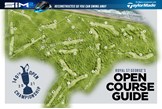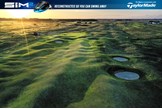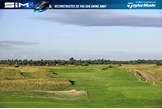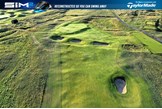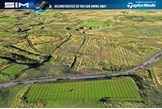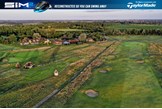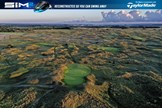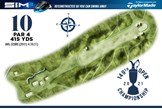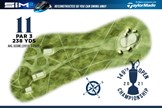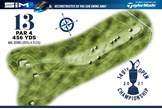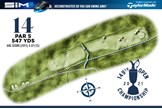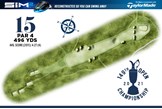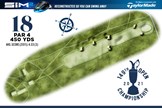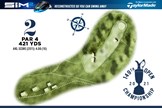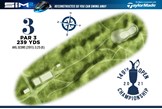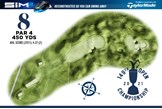The Open 2021: Royal St George’s course guide
Published: Last updated:
Our 18-hole course guide to Royal St George’s Golf Club, host of the 149th Open Championship and one of the toughest tests on the Major’s rota.
Today’s Golfer’s 2021 Major coverage is brought to you in association with TaylorMade.
The wait is almost over. Ten years after its last appearance in Kent, and a year later than originally billed, The Open Championship returns to the Garden of England with thousands of fans due to descend on Sandwich from July 12th to 18th and the kind of drama you only ever see on a links course.
THE OPEN 2021: Live leaderboard and videos

Royal St George’s is, according to our Golf World Top 100 rankings, the best course in England and sixth best links golf course in Great Britain and Ireland and, if you’ve played it before, then you’ll know that the players won’t have it easy in their quest to lift the year’s final men’s Major.
RELATED: Golf World Top 100 Courses in England
‘It’s just one of those golf courses where, if you get aggressive with it, you can end up looking very silly,’ said four-time Major winner and 2014 Open champion Rory McIlroy.

McIlroy and his colleagues will be battling Mother Nature as well as dramatic dunes, and hitting a high proportion of blind shots from some of the most undulating, crumpled fairways in England. It rates among the toughest venues on The Open rota and yet it has produced some of the most memorable moments – and implosions – in Major Championship history.
THE OPEN 2021: Win TaylorMade’s Open staff bag!

Going against the modern preference for longer and stronger, The R&A have taken the unusual step of snipping 22 yards off the yardage this year, so the course will play shorter than it did when Darren Clarke lifted the Claret Jug in 2011. Indeed, the fact that only three of the past 14 Open winners have finished under par here may also explain why any tinkering has largely been limited to adding and moving a few bunkers to catch out the bigger hitters.
THE OPEN 2021: The inside story of Royal St George’s Golf Club
WATCH: Darren Clarke’s 2011 Open Championship win
The expectation – among members at least – is that their course will not be overpowered. Whether that turns out to be true only time will tell, but we are confident that no one will be complaining when the grandstands are packed and we finally get to crown a new Champion Golfer of the Year. We’ve waited long enough.
RELATED: Golf World Top 100 Links Courses in GB and Ireland
The Open 2021: How the course will be set up
Paul Larsen, Course Manager at Royal St George’s, tells Today’s Golfer how he and his team will be setting the Sandwich links up for play for the year’s final men’s Major.

You wouldn’t believe what the course looked like a few years ago.
In 2018, we had a drought so the fairways were almost half bare. We lost a lot of grass and ran out of water. We’ve spent the last two years getting the course in shape and it looks amazing compared to where we were.
The yardage this year is actually going to be shorter than it was in 2011.
I’ve made all the greens bigger by miles and brought a lot of them forward. The fairways are slightly wider and we’ve tried to make it so if you hit the fairway, you should hang in to the semi rough worst case, not into thick rough. We’ve also added one bunker and taken others out, but I suppose the big change is the 4th. We took the sleepers out on the 4th to make it look more natural. It looks completely different, but it’s still the same height.
We’re going to be moving some tees around – that’s never been done before.
As a result, there could be some unusual yardages and par 4s which are driveable. Off the top of my head, the 2nd may be possible if it’s downwind. The 5th we’ve added a front tee which wasn’t there in the last Open. The 12th is driveable for Bryson and, believe it or not, the 17th is if it’s downwind. Luke Donald doesn’t hit the ball far and he nearly drove the green on the practice day in 2011.
There’s no hole where there’s an easy birdie.
It’s all about putting the ball in the right spot on the greens and missing in the right places. There’s lots of subtle breaks and we want the greens as firm as possible this year. I’ve also cut some 50 to 60-yard aprons. The lies are going to be tight, so you’re going to see a lot of people putting off the green, especially if it’s dry and firm.
THE OPEN 2021: 10 things you need to know about Royal St George’s

I always describe St George’s as a golf course within a dune.
It’s the most natural piece of land that hasn’t been bulldozed to create level fairways. Look at 12 and all the ripples and humps. You can’t practice for that. Matt Fitzpatrick came here last year and had been told that he wasn’t going to enjoy it because of the blind shots and never having a level lie. But he shot 67 and absolutely loved it.
Everyone wants thick rough this year and that’s what they’re going to get.
We haven’t cut the rough down. We’re letting it grow naturally, so it’s going to be long. That’s why you’ve got to hit the fairways. Bryson powered his way through the US
Open, but there’s no way he can prosper here if he’s hitting it in the rough. You just won’t be able to hit it close.
RELATED: Win the ultimate Open prize package
The Open 2021: Royal St George’s course guide
Par 70, 7,189 yards
Front nine: Par 35 (six par 4s, two par 3s, one par 5) | 3,620 yards
Back nine: Par 35 (six par 4s, two par 3s, one par 5) | 3,569 yards
In the event of a tie after 72 holes, a three-hole aggregate play-off will be held on holes 16, 17 and 18; followed by sudden death on the 18th if the lead is still tied.

Royal St George’s 1st hole
Par 4 | 445 yards | Average score at 2011 Open: 4.22 (8th hardest)
Widely regarded as one of the toughest starts in Championship golf, with thick rough either side of the fairway and a green which slopes away from players. The tee shot should favour the flatter left side of the fairway, but it needs to carry 250 yards over a deep swale, known as ‘the Kitchen’.
The wide green is guarded by a trio of bunkers which collect any approach shots that come up short or left, particularly those from the rough. Tiger Woods famously started with a triple bogey here in the 2003 Championship after losing his tee shot, while Jerry Kelly carded an 11 in 1993.

Royal St George’s 2nd hole
Par 4 | 421 yards | Average score in 2011: 4.06 (16th)
A sweeping right-to-left dog-leg which turns towards the coast. It’s 250 yards to carry the two bunkers on the corner of the dog-leg, but most pros will take a 3-wood for position and favour the right side of the fairway to leave a better angle in with a short iron.
Any approach drifting right or left will run into a little hollow, leaving a difficult pitch to a small, raised green which falls away at the edges, a recurring feature at Royal St George’s.
THE OPEN 2021: The inside story of Ben Curtis’ incredible victory

Royal St George’s 3rd hole
Par 3 | 239 yards | Average score in 2011: 3.25 (6th)
Prior to Royal Portrush rejoining, this was the only par 3 on The Open rota not to feature a bunker. Mounds cradle the green and often deflect balls from the right back onto a two-tier putting surface which is just 15 yards wide.
Statistically it is one of the most difficult short holes in Open history. The hardest pin is on the bottom level.

Royal St George’s 4th hole
Par 4 | 491 yards | Average score in 2011: 4.52 (1st)
Played as a par 5 during the 2003 Open and named after the ‘Keeper’s Cottage situated behind the green.
The priority off the tee is to avoid the Himalaya bunker, which is the second largest in England, at more than 40 feet. Those who attack it – and most players will – need to carry 270 yards to find a flat area of fairway, which lies beyond a large dune known as the ‘Elysian Fields’.
The approach plays to a green with a deep depression front-left and white posts three paces over the back. The margin for error is small and anything coming up short or too far right will be deposited into a hollow with a six-foot climb back up. In 2011, this hole yielded more double bogeys (26) than birdies (16).

Royal St George’s 5th hole
Par 4 | 422 yards | Average score in 2011: 4.11 (12th)
Perhaps best remembered for John Daly driving the green – with a strong wind assist – during practice in 1993.
A first sight of the sea is present from the tee, where players must choose which section of the split fairway to aim for. The bold will look to cut the corner of the dog-leg and take on a carry in excess of 320 yards to clear five bunkers and many more dune ridges. A sub 260-yard lay-up is the safer option and stops players from running through the fairway.
Did you know? Campbell’s Table is named after American Bill Campbell, who landed on the plateau in each of his four matches in the 1967 Walker Cup. He won all of them.
THE OPEN 2021: How to watch all the action from Royal St George’s

Royal St George’s 6th hole
Par 3 | 174 yards | Average score in 2011: 3.21 (9th)
Nicknamed ‘The Maiden’ after the huge greenside dune that rises high above its surroundings, this is the best vantage point on the course for Open spectators.
Four deep pot bunkers add extra protection to the green, which is set on a 45-degree angle to the tee and divided into two tiers by a ridge that runs through the middle. In 2011, Tom Watson’s hole-in-one overshadowed the fact that there were more double bogeys or worse here than any other par 3 on Royal St George’s.

Royal St George’s 7th hole
Par 5 | 566 yards | Average score in 2011: 4.56 (18th)
“One of the friendliest par 5s you will find,” says broadcaster Andrew Cotter. It’s hard to disagree, especially when you look at the average score from 2011.
The drive plays blind to a fairway which is overlooked by high dunes on the left and sits hidden behind the crest of a hill some 280 yards in the distance. The hole turns slightly left for the second shot and normally benefits from a prevailing wind – which might explain why 19 of the 23 eagles in 2011 were made here.
Both Darren Clarke and Phil Mickelson made a three in the final round after flirting with the steep-sided bunker on the right and using the contours to run the ball onto the green.

Royal St George’s 8th hole
Par 4 | 450 yards | Average score in 2011: 4.37 (2nd)
From the ‘easiest’ hole to one that is traditionally the most difficult hole at Royal St George’s. The 8th was originally a par 3 but turned into a dog-leg right par 4 as part of the course changes that preceded the return of The Open in 1981.
Club selection off the tee is key to keep out of the bunkers on the right and to avoid running out of fairway at 325 yards, especially as the final 25 yards is all downhill.
The approach is just as tricky to judge and plays over 80 yards of rough to a long and slender target nestled between sandhills and bisected by a ridge. It’s not uncommon to see 40 yards of run in the summer, so expect to see balls being chased onto the green.

Royal St George’s 9th hole
Par 4 | 412 yards | Average score in 2011: 4.24 (7th)
The 9th originally played along the ridge that extends down its right-hand side, but the fairway now snakes between dunes which can guide off-line drives back to the short grass.
The drive must stay short of the two traps at 329 yards, and from there it’s a pitch to a slightly plateaued but fiercely undulating green that falls off to the right and is fraught with danger on the left.
RELATED: The Open – Tee times and groupings
Where The Open Championship will be won and lost
Mark Batten, Past Captain and Chairman of the Championship Committee, gives us the inside track on The R&A’s plans for forward tees and where The Open at Royal St Georges will be decided…
Prodigious length will not always help you. You can be up greenside and easily take three or four to get down, especially from the rough. I’m told Jack Nicklaus didn’t like the course because he thought the bounces were unfair. If it’s firm, you can’t land your ball on the green and expect it to hold. I remember coming in 2011 and on the 17th many players were hitting pitching wedges and watching it ping off the green towards the back. Whereas a member would nudge it up, using the swales.
It’s a course which certainly calls for a lot of imagination. In 2003, Ben Curtis came before hand, and he was the only player to speak to the pro at the time and ask him how to play the course.
A lot of the greens are well protected so you can’t bomb it all over the place. Bryson could try and drive the 5th like John Daly did, and the 12th is another where he could blast it, but if he misses the green then there’s plenty of trouble. A lot of the bunkers are reasonably deep and whenever you miss the fairway, the hosel can easily snag in the fescue and make it pretty difficult to get out.

I sense The R&A like a bit of risk and reward and want to throw up a few surprises. They seem quite attracted to using a front tee on 11, which is about 60 yards further forward. I think they rather like the idea of almost replicating the Postage Stamp where the angle to the pin means the landing area is very small.
It’s a course which calls for a lot of courage and imagination. There’s lots of places, even on the fairway, where the ball will be two or three inches below or above you. You’ve got to plot your way around and even if you think you’re doing well, you can’t let up or relax. No two holes go in exactly the same direction and the wind often moves around so you never ever feel comfortable. It’s sometimes said that the last five or six holes have quite a sting. I think most players will be happy playing them in level par.
THE OPEN 2021: Shane Lowry – “Winning at Portrush hasn’t changed me”

Royal St George’s 10th hole
Par 4 | 415 yards | Average score in 2011: 4.19 (11th)
Often played into wind, this left-hand dog-leg plays much longer than 415 yards because of its steep rise.
The bunker is not really in play off the tee, so it’s all about the approach from a sloping lie to an exposed, elevated green. Thick rough at the back is especially severe and a second shot that is not kept right of centre will likely run into one of two deep traps on the left.
The best play is to aim for the front apron, but misjudge it slightly and the ball can trickle down the hill, leaving a tough pitch from a tight lie over sand.
Did you know? Ian Fleming once described this as the most dangerous par 4 in James Bond’s match with Goldfinger. Tom Kite found that out the hard way, going from bunker to bunker to destroy his Open chances when leading in 1985.

Royal St George’s 11th hole
Par 3 | 238 yards | Average score in 2011: 3.25 (5th)
Played back out towards the ocean, the 11th used to be a par 4 but now represents the longest par 3 on the course.
The prevailing wind is south-westerly and shortens the yardage, but a significant right-to-left slope on the green makes putts difficult to read and means any shot turning left will be thrown towards three bunkers.
Mounding behind the two-tier green can help slow down a shot coming in hot, though it’s not uncommon to see balls finding a gully with a sticky bank at the back. Most caddies will pick a line just a yard left of the two traps on the right.
RELATED: The Open 2021 – Full field and how they qualified

Royal St George’s 12th hole
Par 4 | 379 yards | Average score in 2011: 4.00 (17th)
The shortest par 4 but certainly not the easiest. It could be driveable if The R&A move the tees forward, though the narrow green is heavily protected by hollows either side and five bunkers blocking the entrance.
Those who lay-up with a long iron will need to avoid a ridge which runs across the right side, kicking balls towards sand on the corner of the dog-leg.
Second shots played right of the flag will usually run towards the hole, but a birdie is never a given on a green which slopes from front to back and has a big drop-off on the left. Tiger Woods even racked up a four-putt here in 2003.

Royal St George’s 13th hole
Par 4 | 456 yards | Average score in 2011: 4.11 (13th)
‘Prince’s’ is another long par 4, taking its name from the old clubhouse of Prince’s GC, which sits beside the longest green on the course.
Likely to be played from the tee on the far right, finding a narrow fairway is not easy, with four bunkers (including one created by a jettisoned WWII bomb) within range. The approach shot is just as tricky and plays to a green with a ridge running down its spine and out of bounds just over the back.
A pin on the left shelf is almost impossible to get close to because of how high it sits, while the right side has a narrow valley with a nasty bunker 10 yards short which needs to be carried.
THE OPEN 2021: Champions on what it takes to win at Royal St George’s

Royal St George’s 14th hole
Par 5 | 547 yards | Average score in 2011: 5.07 (15th)
A brutal hole which has been responsible for three of the eight highest par-5 scoring averages in The Open since 1982. In 2003 and 2011, the average score was 5.3 and 5.07 respectively.
“14 is one of those holes that looms in the back of your mind all day. You’re challenged with one of the most difficult tee shots in championship golf,” says Bill Rogers, who won the 1981 Open Championship at Royal St George’s.

An out-of-bounds fence runs all the way down the right – including just eight paces from the edge of the green – and famously caught out Dustin Johnson when he was chasing down Darren Clarke 10 years ago.
Most players bail out to the left off the tee where the hay is pretty thick, though the bigger hitters will need to lay back from ‘Suez Canal’ – St George’s version of the Swilcan Burn – which splits the fairway in two around 330 yards from the tee.
Did you know? Henrik Stenson ran up a running up a sextuple-bogey 11 here in 2011 after blasting two balls onto the neighbouring
Prince’s.

Royal St George’s 15th hole
Par 4 | 496 yards | Average score in 2011: 4.27 (4th)
The longest par 4 on the course and arguably the toughest as well. Even a drive of 300 yards beyond five bunkers leaves a challenging carry over three cross bunkers to a small, saucer-shaped target framed by mounds on the left and a run-off area on the right. Shots that miss on the left face a really challenging pitch over a bank.

Royal St George’s 16th hole
Par 3 | 162 yards | Average score in 2011: 3.07 (14th)
The last short hole at Royal St George’s and wind plays a big part. Thomas Bjorn’s hope of lifting the Claret Jug evaporated here in 2003 after catching the false right shelf and taking three to get out of the sand on the right.
The back-to-front green is ring fenced by seven bunkers in all but is actually more generous and easier to read than most. It was here that Tony Jacklin celebrated the first televised hole-in-one at the 1967 Dunlop Masters tournament.
THE OPEN 2021: Which golf courses host The Open and why?

Royal St George’s 17th hole
Par 4 | 426 yards | Average score in 2011: 4.20 (10th)
The penultimate hole is a gentle dog-leg from right to left that features a fairway full of swales and humps.
Distance control is crucial with the second shot. Under-hit approaches will be punished by a false front, while anyone who goes over the back will have an even tougher shot coming back unless the pin is on the front of the green. Two pairs of bunkers lurk either side as well, meaning there’s little margin for error on what is a very narrow target.
“If you are in contention on Sunday, you just have to keep you ball left of the pin and give yourself a 20- or 30-foot putt if possible,” says Justin Rose.

Royal St George’s 18th hole
Par 4 | 450 yards | Average score in 2011: 4.33 (3rd)
One of the most fearsome finishing holes on The Open rota, the 18th at Royal St George’s played to an average of 4.62 in 1985. Drives down the left side of the fairway bring a chain of three bunkers into play but offer the best angle to a small, narrow target with out of bounds five yards over the back.

The green is framed by two bunkers and a shallow ridge which funnels balls left of centre into a dip known as ‘Duncan’s Hollow’. From there, Sandy Lyle needed two attempts to find the putting surface on his way to victory in 1985.
Did you know? The area to the left of the 18th green refers to the 1922 Open, when George Duncan needed a four to tie with Walter Hagen but failed to get up and down from the hollow.



